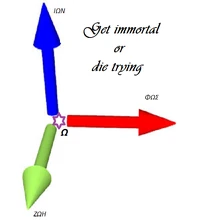Τηλεπαραλληλισμός
Teleparallelism, List of quantum field theories
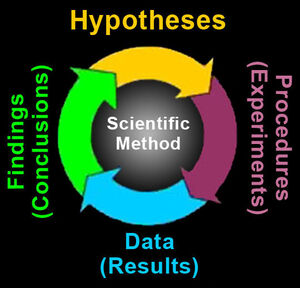
Φυσικές Θεωρίες Χημικές ΘεωρίεςΓεωλογικές Θεωρίες Βιολογικές Θεωρίες Οικονομικές Θεωρίες Φιλοσοφικές Θεωρίες
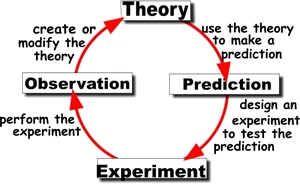
Φυσική Θεωρία Χημική Θεωρία Γεωλογική Θεωρία Βιολογική Θεωρία Οικονομική Θεωρία
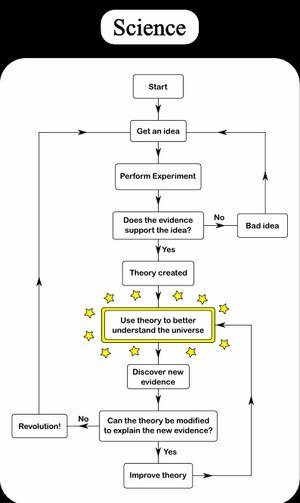
Στάδια ανάπτυξης μίας Επιστημονικής Θεωρίας
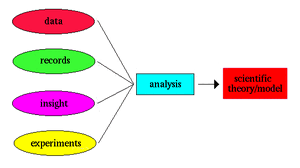
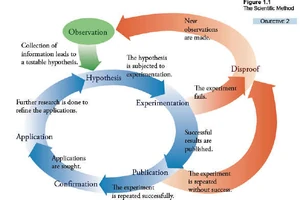
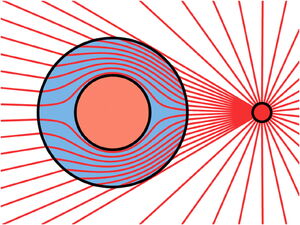
Πεδίο Φυσικό Πεδίο Κλασσικό Πεδίο Κβαντικό Πεδίο Βαρυτικό Πεδίο Ηλεκτρικό Πεδίο Μαγνητικό Πεδίο Ηλεκτρομαγνητικό Πεδίο Ασθενές Πεδίο Ηλεκτρασθενές Πεδίο Χρωμικό Πεδίο Ενιαίο Πεδίο
Ομογενές Πεδίο Κεντρικό Πεδίο Σωληνοειδές Πεδίο Συντηρητικό Πεδίο
Μαθηματικό Πεδίο Βαθμωτό Πεδίο Ανυσματικό Πεδίο Τανυστικό Πεδίο
- Μια Φυσική Θεωρία.
Ετυμολογία[]
Η ονομασία "Τηλεπαραλληλισμός" σχετίζεται ετυμολογικά με την λέξη "παραλληλία".
Εισαγωγή[]
Teleparallelism (also called teleparallel gravity), was an attempt by Einstein[1] to base a unified theory of electromagnetism and gravity on the mathematical structure of distant parallelism, also referred to as absolute or teleparallelism. In this theory, a spacetime is characterized by a curvature-free linear connection in conjunction with a metric tensor field, both defined in terms of a dynamical tetrad field.
Teleparallel spacetimes[]
The crucial new idea, for Einstein, was the introduction of a tetrad field, i.e., a set of four vector fields defined on all of such that for every the set is a basis of , where denotes the fiber over of the tangent vector bundle . Hence, the four-dimensional spacetime manifold must be a parallelizable manifold. The tetrad field was introduced to allow the distant comparison of the direction of tangent vectors at different points of the manifold, hence the name distant parallelism. His attempt failed because there was no Schwarzschild solution in his simplified field equation.
In fact, one can define the connection of the parallelization (also called Weitzenböck connection) to be the linear connection on such that [2]
- ,
where and are (global) functions on ; thus is a global vector field on . In other words, the coefficients of Weitzenböck connection with respect to are all identically zero, implicitly defined by:
hence for the connection coefficients (also called Weitzenböck coefficients) —in this global basis. Here is the dual global basis (or co-frame) defined by .
This is what usually happens in Rn, in any affine space or Lie group (for example the 'curved' sphere S3 but 'Weitzenböck flat' manifold).
Using the transformation law of a connection, or equivalently the properties, we have the following result.
Proposition. In a natural basis, associated with local coordinates , i.e., in the holonomic frame , the (local) connection coefficients of the Weitzenböck connection are given by:
- ,
where are the local expressions of a global object, that is, the given tetrad.
Weitzenböck connection has vanishing curvature, but —in general— non-vanishing torsion.
Given the frame field , one can also define a metric by conceiving of the frame field as an orthonormal vector field. One would then obtain a pseudo-Riemannian metric tensor field of signature (3,1) by
- ,
where
- .
The corresponding underlying spacetime is called, in this case, a Weitzenböck spacetime.[3]
It is worth noting to see that these 'parallel vector fields' give rise to the metric tensor as a by-product.
New teleparallel gravity theory[]
New teleparallel gravity theory (or new general relativity) is a theory of gravitation on Weitzenböck space-time, and attributes gravitation to the torsion tensor formed of the parallel vector fields.
In the New teleparallel gravity theory the fundamental assumptions are as follows: (A) Underlying space-time is the Weitzenböck space-time, which has a quadruplet of parallel vector fields as the fundamental structure. These parallel vector fields give rise to the metric tensor as a by-product. All physical laws are expressed by equations that are covariant or form invariant under the group of general coordinate transformations. (B) The equivalence principle is valid only in classical physics. (C) Gravitational field equations are derivable from the action principle. (D) The field equations are partial differential equations in the field variables of not higher than the second order.
In 1961 Møller[4] revived Einstein’s idea, and Pellegrini and Plebanski[5] found a Lagrangian formulation for absolute parallelism.
Møller Tetrad Theory of Gravitation[]
In 1961, Møller[6][7] showed that a tetrad description of gravitational fields allows a more rational treatment of the energy-momentum complex than in a theory based on the metric tensor alone. The advantage of using tetrads as gravitational variables was connected with the fact that this allowed to construct expressions for the energy-momentum complex which had more satisfactory transformation properties than in a purely metric formulation.
Recently it has been shown that total energy of matter and gravitation is proportional to Ricci scalar of three-space up to linear order of perturbation.[8]
New translation teleparallel gauge theory of gravity[]
In 1967, quite independently, Hayashi and Nakano[9] revived Einstein’s idea, and Pellegrini—Plebanski[10] started to formulate the gauge theory of the space-time translation group. Hayashi pointed out the connection between the gauge theory of space-time translation group and absolute parallelism. The first fiber bundle formulation was provided by Cho.[11] This model was later studied by Schweizer et al.,[12] Nitsch and Hehl, Meyer, and more recent advances can be found in Aldrovandi and Pereira, Gronwald, Itin, Maluf and da Rocha-Neto, Muench, Obukhov and Pereira, and Schucking and Surowitz.
Nowadays, people study teleparallelism purely as a theory of gravity [13] without trying to unify it with electromagnetism. In this theory, the gravitational field turns out to be fully represented by the translational gauge potential , as it should be for a gauge theory for the translation group.
If this choice is made, then there is no longer any Lorentz gauge symmetry because the internal Minkowski space fiber-over each point of the spacetime manifold—belongs to a fiber bundle with the abelian R4 as structure group. However, a translational gauge symmetry may be introduced thus: Instead of seeing tetrads as fundamental, we introduce a fundamental R4 translational gauge symmetry instead (which acts upon the internal Minkowski space fibers affinely so that this fiber is once again made local) with a connection B and a "coordinate field" x taking on values in the Minkowski space fiber.
More precisely, let be the Minkowski fiber bundle over the spacetime manifold M. For each point , the fiber is an affine space. In a fiber chart , coordinates are usually denoted by , where are coordinates on spacetime manifold M, and xa are coordinates in the fiber .
Using the abstract index notation, let a, b, c, ... refer to and μ, ν, ... refer to the tangent bundle . In any particular gauge, the value of xa at the point p is given by the section
is defined with respect to the connection form B, a 1-form assuming values in the Lie algebra of the translational abelian group R4. Here, d is the exterior derivative of the ath component of x, which is a scalar field (so this isn't a pure abstract index notation). Under a gauge transformation by the translation field αa,
and
and so, the covariant derivative of is gauge invariant. This is identified with the translational (co-)tetrad
which is a one-form which takes on values in the Lie algebra of the translational abelian group R4, whence is gauge invariant.[14] But what does this mean? is a local section of the (pure translational) affine internal bundle , another important structure in addition to the translational gauge field . Geometrically, this field determines the “origin” of the affine spaces; it is known as Cartan’s “radius vector”.
In the gauge-theoretic framework, the 1-form
arises as the nonlinear translational gauge field with interpreted as the Goldstone field describing the spontaneous breaking of the translational symmetry.
A crude analogy: Think of as the computer screen and the internal displacement as the position of the mouse pointer. Think of a curved mousepad as spacetime and the position of the mouse as the position. Keeping the orientation of the mouse fixed, if we move the mouse about the curved mousepad, the position of the mouse pointer (internal displacement) also changes and this change is path dependent; i.e., it doesn't only depend upon the initial and final position of the mouse. The change in the internal displacement as we move the mouse about a closed path on the mousepad is the torsion.
Another crude analogy: Think of a crystal with line defects (edge dislocations and screw dislocations but not disclinations). The parallel transport of a point of along a path is given by counting the number of (up/down, forward/backwards and left/right) crystal bonds transversed. The Burgers vector corresponds to the torsion. Disinclinations correspond to curvature, which is why they are left out.
The torsion, i.e., the translational field strength of Teleparallel Gravity (or the translational "curvature"),
is gauge invariant.
Of course, we can always choose the gauge where xa is zero everywhere (a problem though; is an affine space and also a fiber and so, we have to define the "origin" on a point by point basis, but this can always be done arbitrarily) and this leads us back to the theory where the tetrad is fundamental.
Teleparallelism refers to any theory of gravitation based upon this framework. There is a particular choice of the action which makes it exactly equivalent [15] to general relativity, but there are also other choices of the action which aren't equivalent to GR. In some of these theories, there is no equivalence between inertial and gravitational masses.
Unlike GR, gravity is not due to the curvature of spacetime. It is due to the torsion.
Non-gravitational contexts[]
There exists a close analogy of geometry of spacetime with the structure of defects in crystal.[16][17] Dislocations are represented by torsion, disclinations by curvature. These defects are not independent of each other. A dislocation is equivalent to a disclination-antidisclination pair, a disclination is equivalent to a string of dislocations. This is the basic reason why Einstein's theory based purely on curvature can be rewritten as a teleparallel theory based only on torsion. There exists, moreover, infinitely many ways of rewriting Einstein's theory, depending on how much of the curvature one wants to reexpress in terms of torsion, the teleparallel theory being merely one specific version of these.[18]
A further application of teleparallelism occurs in quantum field theory, namely, two-dimensional non-linear sigma models with target space on simple geometric manifolds, whose renormalization behavior is controlled by a Ricci flow, which includes torsion. This torsion modifies the Ricci tensor and hence leads to an infrared fixed point for the coupling, on account of teleparallelism ("geometrostasis").[19]
Υποσημειώσεις[]
- ↑ A. Einstein (1928). "Riemann-Geometrie mit Aufrechterhaltung des Begriffes des Fernparallelismus". Preussische Akademie der Wissenschaften, Phys.-math. Klasse, Sitzungsberichte 1928: 217–221.
- ↑ Bishop, R.L.; Goldberg, S.I. (1968), Tensor Analysis on Manifolds, σελ. 223
- ↑ On the History of Unified Field Theories
- ↑ C. Møller (1961). "Conservation laws and absolute parallelism in general relativity". K. Dan. Vidensk. Selsk. Mat. Fys. Skr. 1 (10): 1–50.
- ↑ C. Pellegrini; J. Plebanski (1963). "Tetrad fields and gravitational fields". Mat. Fys. Skr. Dan. Vid. Selsk. 2 (4): 1–39.
- ↑ Møller, Christian (1961). "Conservation laws and absolute parallelism in general relativity". Mat. Fys. Dan. Vid. Selsk. 1 (10): 1–50.
- ↑ Møller, Christian (1961). "Further remarks on the localization of the energy in the general theory of relativity". Ann. Phys. 12 (1): 118–133. doi:. Bibcode: 1961AnPhy..12..118M.
- ↑ Abedi, Habib; Salti, Mustafa (2015-07-31). "Multiple field modified gravity and localized energy in teleparallel framework" (στα en). General Relativity and Gravitation 47 (8): 93. doi:. ISSN 0001-7701. http://link.springer.com/article/10.1007/s10714-015-1935-z.
- ↑ K. Hayashi; T. Nakano (1967). "Extended Translation Invariance and Associated Gauge Fields". Prog. Theor. Phys. 38 (2): 491–507. doi:. Bibcode: 1967PThPh..38..491H.
- ↑ C. Pellegrini; J. Plebanski (1963). "Tetrad fields and gravitational fields". Mat. Fys. Skr. Dan. Vid. Selsk. 2 (4): 1–39.
- ↑ Y.M. Cho (1976). "Einstein Lagrangian as the translational Yang–Mills Lagrangian". Physical Review D 14: 2521. doi:. Bibcode: 1976PhRvD..14.2521C.
- ↑ M. Schweizer; N. Straumann; A. Wipf (1980). "Postnewtonian generation of gravitational waves in a theory of gravity with torsion". Gen. Rel. Grav. 12: 951–961. doi:. Bibcode: 1980GReGr..12..951S.
- ↑ Arcos, H.I.; J.G. Pereira (January 2005). "Torsion Gravity: a Reappraisal". Int.J.Mod.Phys. D 13 (10): 2193–2240. doi:. Bibcode: 2004IJMPD..13.2193A.
- ↑ F.W. Hehl; J.D. McCrea; E.W. Mielke; Y. Ne’eman (1995). "Metric-affine gauge theory of gravity: field equations, Noether identities, world spinors, and breaking of dilation invariance". Phys. Rep. 258: 1–171. doi:. Bibcode: 1995PhR...258....1H.
- ↑ Y.M. Cho (1976). "Einstein Lagrangian as the translational Yang–Mills Lagrangian". Physical Review D 14: 2521. doi:. Bibcode: 1976PhRvD..14.2521C.
- ↑ H. Kleinert (1989). Gauge Fields in Condensed Matter Vol II. σελ. 743–1440. http://users.physik.fu-berlin.de/~kleinert/kleiner_reb1/contents2.html.
- ↑ H. Kleinert (2008). Multivalued Fields in Condensed Matter, Electromagnetism, and Gravitation. σελ. 1–496. http://users.physik.fu-berlin.de/~kleinert/b11/psfiles/mvf.pdf.
- ↑ H. Kleinert (2010). New Gauge Symmetry in Gravity and the Evanescent Role of Torsion. σελ. 287–298. http://users.physik.fu-berlin.de/~kleinert/385/385.pdf.
- ↑ Braaten, E.; Curtright, T. L.; Zachos, C. K. (1985). "Torsion and geometrostasis in nonlinear sigma models". Nuclear Physics B 260 (3–4): 630. doi:. Bibcode: 1985NuPhB.260..630B.
Εσωτερική Αρθρογραφία[]
- Metric-affine gravitation theory
- Gauge gravitation theory
- Gauge theory gravity
- Loop quantum gravity
- Φυσικό Πεδίο
- Φυσική Θεωρία
- Κλασσική Πεδιακή Θεωρία
- Σχετικιστική Πεδιακή Θεωρία
- Κβαντική Πεδιακή Θεωρία
- Τοπολογική Πεδιακή Θεωρία (Topological field theory )
- Σύμμορφη Πεδιακή Θεωρία (conformal field theory)
- Κρυσταλλική Πεδιακή Θεωρία (Crystal field theory)
- Effective field theory
- Unified field theory
- Mean field theory
- Gauge field theory
- Ligand field theory
- Psychological field theory
- Sociological field theory
- Class field theory
- String field theory
- Statistical field theory
- Local class field theory
- Covariant Hamiltonian field theory
- Thermal quantum field theory
- Toda field theory
- Local quantum field theory
- Lattice field theory
- Liouville field theory
- Noncommutative quantum field theory
- Phenomenal field theory
- Polymer field theory
- Qubit field theory
- Decision field theory
- Lexical field theory
- Dynamical mean field theory
- Algebraic quantum field theory
- Constructive quantum field theory
- Rational conformal field theory
- Irrational conformal field theory
- Logarithmic conformal field theory
- Boundary conformal field theory
Βιβλιογραφία[]
- Bishop, R.L.; Goldberg, S.I. (1968), Tensor Analysis on Manifolds (First Dover 1980 έκδοση), The Macmillan Company, ISBN 0-486-64039-6
- Weitzenböck, R. (1923), Invariantentheorie, Groningen: Noordhoff
- Aldrovandi, R.; Pereira, J.G. (2012), Teleparallel Gravity: An Introduction, Springer: Dordrecht, ISBN 978-94-007-5142-2
Ιστογραφία[]
- Ομώνυμο άρθρο στην Βικιπαίδεια
- Ομώνυμο άρθρο στην Livepedia
- Πρότυπο:Nlab
- Teleparallel Structures and Gravity Theories by Luca Bombelli
- Selected Papers on Teleparallelism, translated and edited by D. H. Delphenich
|
Αν και θα βρείτε εξακριβωμένες πληροφορίες "Οι πληροφορίες αυτές μπορεί πρόσφατα Πρέπει να λάβετε υπ' όψη ότι Επίσης, |
- Μην κάνετε χρήση του περιεχομένου της παρούσας εγκυκλοπαίδειας
αν διαφωνείτε με όσα αναγράφονται σε αυτήν
- Όχι, στις διαφημίσεις που περιέχουν απαράδεκτο περιεχόμενο (άσεμνες εικόνες, ροζ αγγελίες κλπ.)














































